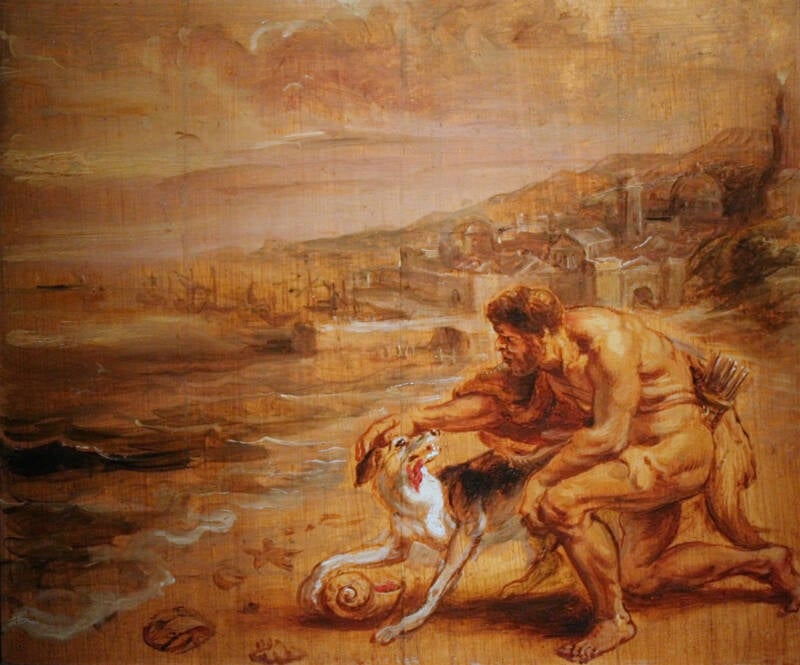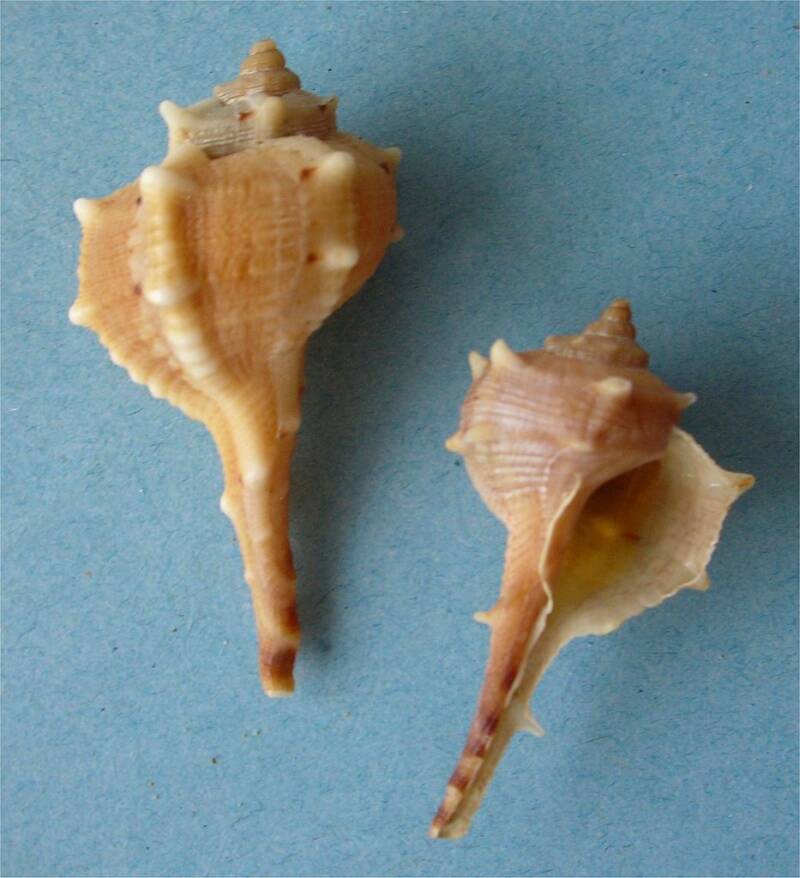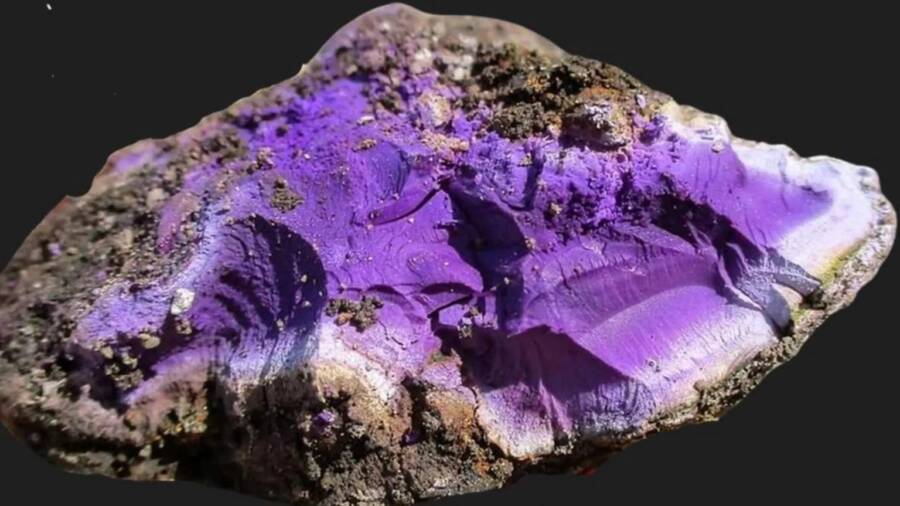A deep, vibrant pigment, Tyrian purple was extracted from the mucus of sea snails and used to clothe elites in the ancient world — but the process to make it has since been lost to time.

Public DomainThe 17th-century Hercules’s Dog Discovers Purple Dye by Peter Paul Rubens depicts the mythical discovery of Tyrian purple by Hercules and his dog.
In one story from Greek myth, Hercules is walking on the beach with his dog when the animal leaps on a sea snail in the surf. The dog emerges from the tussle with a muzzle dyed purple. When Hercules later tries to woo a nymph named Tyro, she notices the dog’s stained fur and demands a robe in the same color. This, according to legend, was the birth of Tyrian purple.
Though the story of Hercules and his dog is a myth, the lust for Tyrian dye was very real in the ancient world. Painstakingly made from the mucus of thousands of sea snails, the pigment was used for cloaks, wall paintings, and more. It commanded exorbitant prices and was reserved for the wealthy.
But by the 15th century, the production of Tyrian dye came to an end.
The Slimy, Ancient Origins Of Tyrian Purple
Tyrian purple dye was first produced in the Phoenician city of Tyre (in present-day Lebanon), perhaps as early as the 16th century B.C.E. The Phoenicians’ legacy is so intertwined with the dye that some historians believe that “Phoenicia” derives from the Greek phoinos, or “dark red.”
In an echo of Greek myth, Phoenician mythology states that the dye was discovered when the god Melqart (who is often identified as Hercules) went for a walk on the beach with his mistress Tyros and her dog. The dog bit a sea snail, emerged with a purple snout, and Tyrian purple was discovered.

Daieuxetdailleurs/Wikimedia CommonsAncient ruins in Tyre, Lebanon.
The story has a romantic element, but making Tyrian dye was anything but.
To produce the dye, ancient people collected thousands of murex sea snails along the beach (species like Hexaplex trunculus, Bolinus brandaris, and Stramonita haemastoma each produced a slightly different shade) and either crushed the snails whole or cut out their tiny mucous glands.
“These shells, when they have been collected, are all broken apart with iron tools, and from these wounds the purple gore, flowing out like tears, is forced out and collected into the mortars for grinding,” the Roman architect and engineer Vitruvius explained about the dye-making process.
The glands were salted, fermented, cooked, and reduced until the mixture resembled clotted blood. After 10 days, dye makers could dip in fabric to check what shade the dye would yield.
“It is considered of the best quality when it has exactly the colour of clotted blood, and is of a blackish hue to the sight,” Roman writer Pliny the Elder explained, “but of a shining appearance when held up to the light; hence it is that we find Homer speaking of ‘purple blood.'”

M.Violante/Wikimedia CommonsTyrian purple came from sea snail shells like these (Haustellum brandaris).
This painstaking process also produced a terrible, overwhelming stench similar to rotting fish and urine. But for dye makers, the rewards far outweighed the costs. Though it could take 10,000 snails to produce a single gram of dye, Tyrian purple was worth more than gold.
A ‘Frantic Passion For Purple’
Tyrian dye was highly sought after by wealthy elites and royals, who draped themselves in purple. In ancient Greece, the right to wear purple was mandated by law. In ancient Egypt, the Ptolemaic queen Cleopatra purportedly used her great wealth to dye the sails of her boats. But no one embraced Tyrian purple quite like the ancient Romans did.

PMRMaeyaert/Wikimedia CommonsJulius Caesar is depicted here wearing Tyrian purple.
Julius Caesar was said to wear a Tyrian purple toga, or toga purpurea. And even after Caesar’s assassination, Roman elites continued to go wild for the hue.
In 40 C.E., passions surrounding Tyrian purple were so intense that when the king of Mauretania draped himself in purple during a meeting with Roman emperor Caligula, the emperor allegedly grew enraged — and had him killed.
“It is for this colour that the fasces and the axes of Rome make way in the crowd,” Pliny the Elder remarked of the Roman madness for the color. “It is this that distinguishes the senator from the man of equestrian rank… Let us be prepared then to excuse this frantic passion for purple, even though at the same time we are compelled to enquire, why it is that such a high value has been set upon the produce of this shell-fish, seeing that while in the dye the smell of it is offensive, and the colour itself is harsh, of a greenish hue.”
Tyrian purple was not just highly desired, but valuable. In 301 C.E, the Roman emperor Diocletian issued an edict which stated that one pound of Tyrian dye cost 150,000 denarii — or three pounds of gold.
It was sought after by emperors like 6th-century Byzantine emperor Justinian I, who is portrayed in Tyrian purple in his famous mosaic, and by Catholic clergymen, who draped themselves in purple for centuries.

Petar Milošević/Wikimedia CommonsA 6th-century mosaic of Emperor Justinian I, draped in Tyrian purple.
Tyrian purple was also sometimes used to color parchment or to paint public buildings, bathhouses, or the homes of elites.
But in the 15th century, Tyrian purple began to fade.
How Tyrian Purple Was Lost To Time
In May 1453, the Ottoman Empire captured Constantinople. This put a definitive end to the Roman Empire. And it also cut off the Catholic Church from the city’s dye industry.
A decade later, in 1464, Pope Paul II solved the problem by declaring that Tyrian purple would be replaced by red. This was cheaper and easier to produce, and has remained an important color in Christianity ever since.
But as the BBC notes, there might have been something even larger than the loss of Constantinople’s dye workshops going on. In 2003, researchers found a dump of some 60 million sea snail shells in Andriake, Turkey. The shells at the bottom of the pile, which had been used up first, were larger and older.
This suggests that the supply of sea snails had greatly diminished around the time Tyrian dye production ceased. Given that it took 10,000 snails to produce one gram of dye, this is hardly a surprise.
In any case, the exact method of making Tyrian dye has been lost to time. Dye makers were notoriously secretive about their individual formulas, and didn’t leave detailed notes about their process. News about Tyrian dye today is mostly restricted to archaeological finds, like the discovery of a chunk of Tyrian dye in England in 2024.

Frank GieccoThe “very rare” chunk of Tyrian dye that was found in Carlisle, England.
That said, some have been able to roughly recreate the dye-making process. According to reporting from Reuters in 2022, Tunisian history enthusiast Mouhamad Ghassen Nouira spent 14 years experimenting with sea snails in hopes of creating the sought-after color. He’s succeeded in producing small amounts of purple powder, but it takes 119 pounds of shells to make one gram of Tyrian purple.
Today, such a venture is no longer economically viable. But for dye makers in antiquity, a dot of purple was worth more than its weight in gold.
After reading about the rise and fall of Tyrian purple, discover the story of Baiae, the sunken party town of ancient Rome. Or, look through these fascinating facts about life in ancient Rome.





